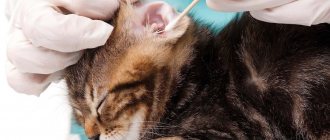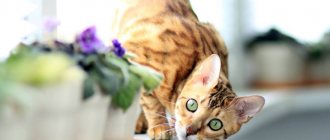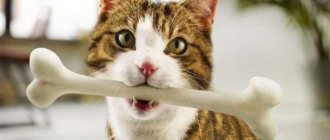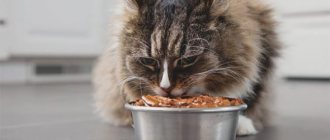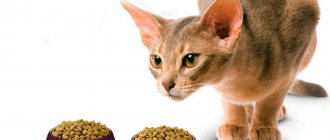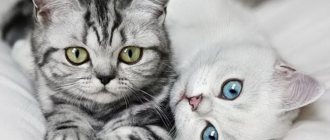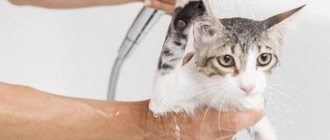A change in the appearance, color and consistency of feces is a malfunction of the pet’s internal organs. Light and white color of feces indicates a pathology of the cat's pancreas, gallbladder or liver.
White feces are a pathology; normally, feces are brown in color. This occurs due to bile secreted in the small intestine.
If this natural process is disrupted, then the shade of the stool becomes different - lighter, and sometimes even completely white. At the same time, the nature and frequency of bowel movements changes.
Bile deficiency in the intestines leads to disruption of the normal course of digestion, which has a detrimental effect on the health and condition of the animal as a whole.
If a cat has white stool, this is always a sign of illness. Often white feces in cats are accompanied by other serious symptoms: diarrhea, mucus, constipation, and bloody feces.
Stagnation of bile in an animal’s body can lead to deep intoxication and even death of the animal. Without proper therapy, the prognosis can be disappointing. To cure a pet, the owner needs to act quickly and competently.
Diagnostics
They begin to look for oncology if none of the above diagnoses are confirmed. If the case is not complex, the tumor is found in the liver, gall bladder or ducts. Secondly, the stomach, small and large intestines are examined.
If there are no results, that is, as a last resort, the doctor may suggest a diagnostic operation. It is worth noting that in this way it is possible to identify oncology even in the early stages.
Before agreeing to such drastic measures, you must ensure that all alternative options have been exhausted:
- A detailed blood test - a violation of the norms may indicate the development of ailments of any organ or vital system.
- Biochemical blood test - abnormal liver function tests indicate that the problem is in the liver or gall bladder.
- Fecal analysis is one of the first to be carried out, since excrement may contain tissue debris (inflammation), sand (cholelithiasis), bone fragments (a cat can steal a bone from a trash can), atypical toxins (poisoning with liver damage), etc.
- Urinalysis - shows the general condition of the body.
- Ultrasound examination of the abdominal organs - if the cat constantly has white feces, several ultrasound examinations are performed (on an empty stomach, after drinking water, after eating, etc.). Using ultrasound, you can identify cysts, neoplasms, degeneration of cells into fibrous tissue, obstruction of the bile ducts, stones and sand in the gallbladder.
- X-ray – allows you to identify tumors, cysts, changes in the shape of the liver, etc.
- Biopsy of affected tissue (most often the liver).
Important! An MRI examination allows you to make an accurate diagnosis and eliminate assumptions.
Naturally, all these examinations are not carried out in one day. Until the diagnosis is established, the doctor determines what to do at home.
Most often, the owner’s role comes down to closely monitoring changes in the pet’s condition and adjusting the diet. Manipulations may be prescribed if the cat is in pain or is in a state of severe intoxication.
Symptoms of helminthiasis
Signs of parasites appearing in an animal’s body can be different. Symptoms directly depend on the type of helminths that have entered the cat’s body and the degree of worm damage.
At the initial stage, the disease does not detect itself, but progresses very quickly, as a result of which the cat becomes weaker day by day.
The main signs of worm infection:
- The animal becomes lethargic and gets tired quickly.
- Small white worms appear in the cat's stool.
- The pet's belly becomes dense and severe bloating can be observed.
- The cat loses its appetite and may refuse food.
- The fur loses its shine and begins to fall out.
- Vomit.
- Problems with passing stool. Constipation alternates with intestinal upset.
- A cat can “ride” on its butt.
- The pet becomes nervous and restless.
Treatment
The key to successful treatment is a complete diet that takes into account the individual needs and condition of the cat. Please note that there can be no talk of cheap food or natural feeding “whatever is necessary”. Even if the cat feels well, small amounts of fatty, spicy, pickled, smoked or other junk food can dramatically worsen its health.
During diagnosis and treatment, the amount of water consumed is strictly controlled. When a cat is dehydrated, bile is not produced or not enough is produced.
When too much water is consumed (for a number of alarming reasons), bile loses concentration, leading to incomplete digestion of food. In the second case, the animal loses weight and suffers from vitamin deficiency.
If formed stones or a tumor that is compressing the liver is detected, there is only one way out - surgery. In all other cases, treatment is selected individually. If there is sand in the gallbladder, the cat is prescribed a therapeutic diet and choleretic drugs. Dissolving sand is a long process, but it does not require rough intervention.
What to do for prevention?
Liquid or dry feces, which are constantly observed in a pet, in any case, are evidence of some kind of internal progressive disorder. To prevent consequences dangerous to the cat’s health and life, it is important to follow preventive rules. First of all, it is important to monitor the cat’s nutrition and provide it with fresh and clean water. Do not forget to carry out preventive anthelmintic treatment.
If viral infectious diseases develop, do not self-medicate, but take the animal to a veterinarian, who, based on the diagnostic results, will select an effective treatment. In order for the cat’s body to more actively resist various diseases, it is useful to strengthen the pet’s immunity. To do this, it is recommended to give courses of vitamins and various biologically active supplements, which are selected by the veterinarian, taking into account the individual characteristics of the cat.
Is a cat whose stool has become light-colored contagious?
Toxoplasmosis, caused by the parasitic protist Toxoplasma, is one of the causes of inflammation of the gallbladder and ducts. For healthy people with good immunity, Toxoplasma poses virtually no threat.
The situation is different for pregnant women or women who become infected on the eve of conception. Parasites can affect the development of the fetus, cause irreversible changes in the development of its internal organs, and provoke miscarriage or stillbirth.
In antenatal clinics, pregnant women are required to undergo testing to detect toxoplasmosis.
Changes in the color of stool may be a consequence of infection with worms, which not only have settled in the intestines, but have also spread throughout the body, including ending up in the liver.
Worms are quickly transmitted from cats to humans, so you need to avoid contact with a sick animal, take special care when cleaning the toilet, and keep children away from it.
Why did my cat's feces change in color?
The factor contributing to this pathology most often is the presence of blood in the stool, but there may be several reasons for this. Bleeding occurs both in the stomach and in different parts of the intestines, which poses a mortal danger to the cat.
This happens in the following cases, each of which requires an individual approach to treatment:
- Worms very often cause this problem. They live in the pet’s intestines, attaching to its walls, thereby violating their integrity. Once in the large intestine, the blood is digested and changes the color of the animal's stool.
- Gastritis or colitis of traumatic origin is an inflammatory process in the stomach or small intestine that is caused by foreign objects. Most often this happens if a cat eats bird bones. When chewed, splintered pieces are obtained that easily injure the internal organs of the animal. Perforations, wounds and microcracks on the walls of organs also appear from other swallowed objects.
- Peptic ulcer of the stomach, duodenum, gastritis and enterocolitis of the same type, all these diseases cause the appearance of bleeding ulcers on the walls of organs, which leads to blackening of the animal’s feces.
- Tumors of the small intestine and stomach, especially malignant ones, lead to ulcers and internal bleeding.
- The hemorrhagic form of gastroenteritis leads to detachment of the epithelium of the mucous membrane of the stomach and some parts of the intestine, injuring small vessels and causing bleeding. This inflammation occurs as a result of complications from severe bacterial and viral infections; the cause may be an autoimmune disease of the animal, severe stress, disturbances in the process of blood clotting, complete intolerance to any food product, food component, or a severe allergic reaction.
Each of the diseases requires urgent and effective treatment. It is impossible to make a diagnosis and select medications on your own.
Treatment at home is only possible if you are completely sure that the pet is suffering from a helminthic infestation. This can only be determined by the presence of parasites in the animal’s feces. But you still can’t do without a consultation and a visit to the veterinarian, since the animal requires not only anti-parasite remedies, but also complex therapy.
How to Prepare Cat Stool Samples for Testing
At each annual exam, your veterinarian may ask you to bring a stool sample for laboratory testing. It is best to collect samples in special plastic containers, which can be purchased at both a veterinary and a “human” pharmacy. Just remember: the lab needs a fresh sample, so collect these “treasures” from the tray the day of your veterinarian visit. Once you collect the feces in an approved plastic specimen container, be sure to sign the date and time of collection so that your veterinarian has accurate information.
Why is my cat's stool white: urgently go to the clinic
The coloring of feces in a light color does not always indicate errors in nutrition.
There are situations when the breeder must deliver the cat to the RosVet Exhibition Center immediately. The list includes:
- liver pathologies occurring with metabolic disorders and inflammation (hepatitis, hepatosis);
- the pancreas does not provide enough enzymes for digestion;
- developmental anomalies of the gallbladder and its ducts (adhesions, torsion);
- cysts, purulent abscesses;
- cirrhosis of the liver (with pathology, little bile is produced);
- cholangiohepatitis, cholangitis (inflammatory process in the bile ducts and bladder).
You should be alert to some kidney diseases, in which there is an accumulation of toxic products in the body, which then affect the functioning of the liver.
Tumors of various origins in the liver and biliary system can interfere with the normal release of bile into the intestines. The absence of bladder contractions (atony) completely stops the flow of bile into the gastrointestinal tract, and there is a risk of rupture and peritonitis.
Diagnostic methods
A thorough examination is required to make a diagnosis and prescribe therapy. First of all, the doctor must find out from the cat’s owners when and under what circumstances the changes began. The diet, previous diseases and features of the clinical picture are refined. After a general examination and temperature measurement, the following diagnostic methods are used in veterinary medicine:
- Analyzes. The cat's blood, urine and feces are taken for examination. The test results allow us to determine the general condition of the furry, the presence of parasites, liver and gallbladder diseases, and poisoning.
- Coagulogram. A study to determine the rate of blood clotting.
- Gastroscopy. Makes it possible to see the true condition of the inner walls of the stomach, detect ulcers or erosion, foreign bodies.
- Ultrasound of the peritoneum. Allows you to determine the presence of neoplasms and cysts, stones or sand in the gallbladder, and intestinal obstruction.
- Radiography. Detects liver enlargement and the presence of tumors.
- Biopsy. If a tumor is detected, the affected tissue is collected for analysis. Against the background of black feces and the accompanying clinic, the liver often suffers.
General examination Clinical examination Ultrasound of the peritoneum
The influence of nutrition on the color of excrement
In veterinary medicine, white feces are called acholic. Literally, this means “lack of bile” (Greek: chole - bile, a - without). But white feces do not always indicate serious health problems.
This is always considered a pathology, but sometimes the condition is reversible in the shortest periods of time only with the help of nutritional correction.
White feces in a cat can be due to:
- feeding with bones (liver function is disrupted);
- states of dehydration (in addition to the color, the stool becomes dense and “free-flowing”);
- improper dosing or long-term use of medications that affect the gastrointestinal tract and liver system (antibiotics, sorbents);
- feeding excessively fatty foods (not always and not for everyone, but often);
- digestive disorders due to stress;
- too much dairy products (stool becomes light yellow, sometimes turning white, due to indigestion due to fermentation in the intestines).
Usually, after eliminating the above reasons, the color of stool returns to normal.
Light-colored stool as a symptom of liver dysfunction
The liver plays one of the main roles in digestion. It is in it that bile acids are formed, which then accumulate in the gallbladder. This is not the only process occurring in the liver that causes the stool to change color to gray or white.
A lot of different processes and metabolisms of various kinds of substances occur in the liver. In particular, the metabolism of bilirubin, during the breakdown of which the coloring pigment stercobilin is formed. Various types of liver dysfunction can also appear as white feces.
What to feed a cat with diarrhea
Many owners are concerned about the question of what to feed their cat during and after diarrhea. The first, main rule is a fasting diet in the first day after the onset of diarrhea. This step may seem pointless, but it is important to understand the following:
- During diarrhea, the mucous membranes work more actively and secrete a lot of fluid.
- Food that enters the intestines ends up in a mucous environment and is not digested.
- Due to incomplete fermentation, food does not soften and scratches the intestinal walls.
Simply put, feeding against the background of full-blown diarrhea is a disservice that will only delay recovery. After eliminating the acute condition, the cat should receive a dietary diet for 3–4 days.
If you do not know the exact reasons for the development of the disease, it is better to exclude whole milk from your diet; fermented milk products and cheeses (without salt) are not included in the exception. Feed your pet boiled meat, low-fat broth, cottage cheese and don’t forget about coarse fibers.
About the structure and appearance of feces
Yes, this may not seem very pleasant, but for the sake of the health and, possibly, the life of your cat, it is necessary to carefully evaluate the appearance, structure, consistency and other characteristics of the feces excreted by the animal.
The norm for cats is brown color and pasty consistency of feces. Again, normally during bowel movements they should be released in one portion. Wateriness and “goat balls” immediately indicate some kind of pathology. By the way, “balls” directly indicate a lack of water in the pet’s diet. This often happens to animals whose owners keep them exclusively on dry food. The yellow color of these pellets may be due to the characteristics of a particular food. It is urgent to show the animal to a veterinarian in the following cases:
- Greenish-yellow or yellowish-white stool with a cheesy consistency. Such symptoms indicate that food in the cat’s gastrointestinal tract is practically not digested.
- Watery, yellow and runny. It is very possible that your pet has a serious eating disorder or even an infection.
- The same yellow feces, but with mucus (especially cloudy), from which an unbearable smell emanates - a clear indication of some kind of infectious disease of the gastrointestinal tract or a massive helminthic infestation.
- Regardless of the color of the stool, the presence of blood in it is an extremely serious sign. There are many reasons for the appearance of blood in stool. They have one thing in common - a potential danger to the health and life of the pet. If there is blood in the feces, call a veterinarian immediately.
The main reason for the appearance of yellow stool is the acceleration of intestinal motility. The fact is that in the duodenum, bile is “injected” into semi-digested food masses. If digestion proceeds normally, bilirubin contained in bile gradually turns into stercobilin. It is this that, by the way, gives feces its characteristic brown color. In cases where the passage of food through the gastrointestinal tract is sharply accelerated (during infections, poisoning, due to worms, etc.), only bilirubin, which has a bright yellow color, reaches its “destination”.
